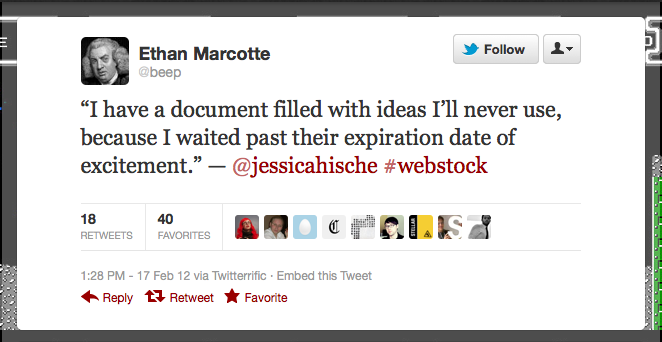By Nathan Donaldson
Tags: Other

Yesterday I posted on two themes I found emerging at Webstock this year: working with designers and crafting experiences. Today I’m turning to finding your joy, strategic creativity and One Big Idea ….
There was a definite sense of reassessment at this year’s Webstock. As Jeff Atwood wrote in a recent blog post, announcing he was stepping away from Stack Exchange, start-up life is hard on families. Walter Isaacson’s biography of Steve Jobs is causing reflection in a generation of people who have been pouring their guts into these ventures for the past decade.
Atwood was cited by Matt Haughey in his talk Lessons from a 40 Year Old. “Success at the cost of being away from your family is not success”, Haughey said, arguing that that world is full of ideas that could be executed in 20-30 hours a week, rather than while living off pizza and Coke and getting 2 hours sleep a night huddled under your desk.
The only thing I wrote in my notebook during this talk was THE SLOW STARTUP MOVEMENT. The shared notes for the session record the examples of long-term successful, self-funded companies, the go-to example being Marco Arment’s Instapaper (and see Arment’s response to Atwood’s announcement).
Amy Hoy also renewed up the Webstock tradition of talking inspiration, not technology. In a talk titled Change the Game, she urged us to ignore the invisible rules and the false dichotomies and to find our happiness instead: a true return to the militant strain of joyousness Webstock so often fosters. (And as a sidenote, try watching Matt Haughey’s talk once it’s online then following up with a dose of Hoy’s Fuck Glory – Start-Ups are One Long Con.)
Two of my favourite talks this year were by people who have a superpower I utterly envy: drawing. I was fascinated by how illustrator, letterer and designer Jessica Hische and designer, developer and cartoonist Matthew Inman have developed their careers.
Hische noted at the start of her talk that illustration and design are very different industries, and that she feels illustration has better deadlines, better customers and a better understanding between client and illustrator. She also noted that having an artist rep makes getting work and negotiating with clients easier, and that when you’re an illustrator, people assume you’ll be doing freelancing on the side, and are perhaps less demanding as a result.
While being endlessly amusing, Hische also had some strong messages about the intent and benefits of side projects (her own reputation having been significantly enhanced by the well-known Daily Drop Cap project). She noted that she often hears people say that they only get work they don’t want to do, and sees this as a reflection that their portfolio doesn’t reflect the kind of work they do want to do. She started Daily Drop Cap for similar reasons:
Hische also coined one of the most tweeted sentiments of the conference, talking about the short shelf-life of ideas:

The shared notes for Matthew Inman (of The Oatmeal fame) are some of the shortest for the whole conference, probably because people were too busy laughing to type. But as with Hische, I was impressed by how Inman has strategically moved away from client work that bored or frustrated him, and made his creativity work for him.
I was struck by how closely Inman watches the stats on his site, and rearranges content or creates new pieces to capitalise on this. I also thought about how ephemeral political satire is (most political cartoons have only days or weeks of relevance) but how a guide to correctly using the word ‘literally‘ will be relevant over and over again. And his short rules are gold:
Okay – it’s not such a big idea. But: the beauty of Webstock is that it makes you want to keep exploring.
I would love each presentation to end with a slide with three books or articles that the speaker recommends, in the spirit of ‘If you liked this talk, you might also like …’. Or perhaps a Webstock Reading List on the Webstock website (a little like the Kiwi Foo reading list).
Webstock is mind candy (with a side-helping of eye candy) and this, combined with the videos of the talks, would make for year-round inspiration.